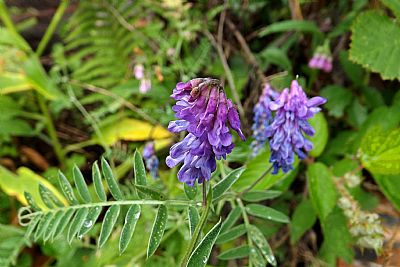VETCH
There are two types, one almost red, the other blue to purple.
VETCH : Vicia cracca
Properly known as tufted vetc h as there are others to be found in the UK.
This fairly common plant with long, twining stems that have curly tendrils on the ends. It is often found on path verges, as here along the Leven towpath, as well as waste ground or along the coast.
It is a member of the pea family so is a legume. However the peas of this plant are toxic when raw. They have to be boiled for long periods in changes of water and are not really worth the effort.
Wildlife Trusts tells us that common vetch is able to make its own nitrates, a special nutrient essential for healthy plant growth. This makes it useful as a soil-fertilising plant and it is also often used as livestock fodder.



Vetch seen in May
VETCH : Vicia sativa
This is very similar, but reddish. Also known as common vetch.
As with its blue relative, it is a member of the pea family. It is able to make its own nitrates, a special nutrient essential for healthy plant growth. This makes it useful as a soil-fertilising plant and it is also often used as livestock fodder. It grows well on grassland, farmland, waste ground and roadside verges, as well as in coastal habitats, such as sand dunes. Groups of one or two pink flowers appear between May and September.[Wildlife Trusts].
It is a scrambling plant with long, twining stems that have curly tendrils on the ends. Its leaves are like folded ovals that sit opposite one another along the stems. Its flowers are pinky-purple and pea-like.
COSTWOLD SEEDS : https://www.cotswoldseeds.com/species/69/vetch
TOTALLY WILD UK : https://totallywilduk.co.uk/2022/02/14/vetch-vicia-sativa-identification/
WILDLIFE TRUSTS : https://www.wildlifetrusts.org/wildlife-explorer/wildflowers/common-vetch

